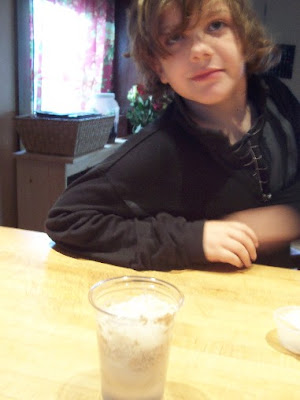This week we did a number of experiments with oil, water, food coloring and various props to explore the property of surfaces. The physical properties like surface tension and solubility are related to the strength of Intermolecular Forces -- the attractive forces between molecules.
Surface Tension Experiments
These came from the website of the Chicago Section of the American Chemical Society
3 bowls or containers with water
liquid soap
pepper
a piece of string
a paper clip
a fork
a needle
Bowl 1:
1. Sprinkle pepper on the surface of cold clean water in a shallow dish. Allow the particles to spread out and cover the surface.
2. Put your finger in the bowl.
3. Put a drop of liquid soap on your finger. Put your finger in the bowl again.
What should happen: Pepper should rush away from your finger in a
star pattern.
What did happen: Pepper rushed away from finger in a circle -- still impressive.
Bowl 2:
1. Float a small loop of string in the middle of the surface of water.
2. Put a drop of liquid soap inside the loop.
What should happen: The surface tension inside the loop of string should weaken by the soap but the surface tension outside the string should have pulled the string outward.
What did happen: The string sank before we could try step 2.
Bowl 3:
1. Lower a paper clip and a needle flat onto the water surface using the fork. They should float.
2. If they don't, place a paper towel on the surface of the water, place the objects on the paper, and then remove the paper.
3. Now put a drop of liquid soap on the water surface.
What should happen: As soon as the tension is broken by the soap, these items should sink to the bottom.
This one worked as planned!
Density Column
Joy of Chemistry, page 131
2 clear glasses or plastic cups
Glycerin
Water
Food coloring
Cooking oil
Liquid soap
Plastic spoon
1. Pour about an inch of water into the cup.
2. Add food coloring to the water.
3. Pour about an inch of glycerin into the second cup.
4. Gently add colored water.
5. Add oil until you get three layers.
6. Stir. Allow to settle.The water will mix with the glycerin, but the oil will separate back out.
7. Add a layer of liquid soap.
8. Stir gently. The oil will mix with the glycerin.
What's Happening: Different liquids have different densities, and according to the density, the liquids will settle in a certain order when mixed. Oil is less dense than water and therefore will settle on top of water.
(NOTE: Glycerin--C
3H
5(OH)
3, which can be bought in drugstores -- can be added to dish soap to make long-lasting bubble solution. Bubbles eventually burst once the layer of water evaporates, but glycerin forms weak hydrogen bonds with water, delaying evaporation.
)
Lava Lamp
(Sorry that it's sideways. When I figure out how to fix it, I will repost it!)
Tall narrow jar
Water
Food coloring
Vegetable oil
Salt
Directions:
1. Fill the cylinder with water.
2. Add the food coloring. Do not let the water become too dark.
3. Slowly pour oil into the cylinder. It should make a thick layer on top of the water.
4. Slowly sprinkle the salt into the cylinder on top of the oil. The salt coats the oil and causes it to fall to the bottom of the graduated cylinder in globs. The oil will gradually return to the top of the graduated cylinder.
What happened:
Vegetable oil is less dense than water. When the salt is added, it sticks to the oil and drags it down. Once at the bottom, the water dissolves the salt and the oil floats back up.
The reason the oil doesn't dissolve into the water happens because of its difference in polarity. Water and salt are both polar. Oil is non-polar. Only polar substances will dissolve polar substances. A non-polar substance will not dissolve in a polar substance. This is the rule of "like dissolves like."


















